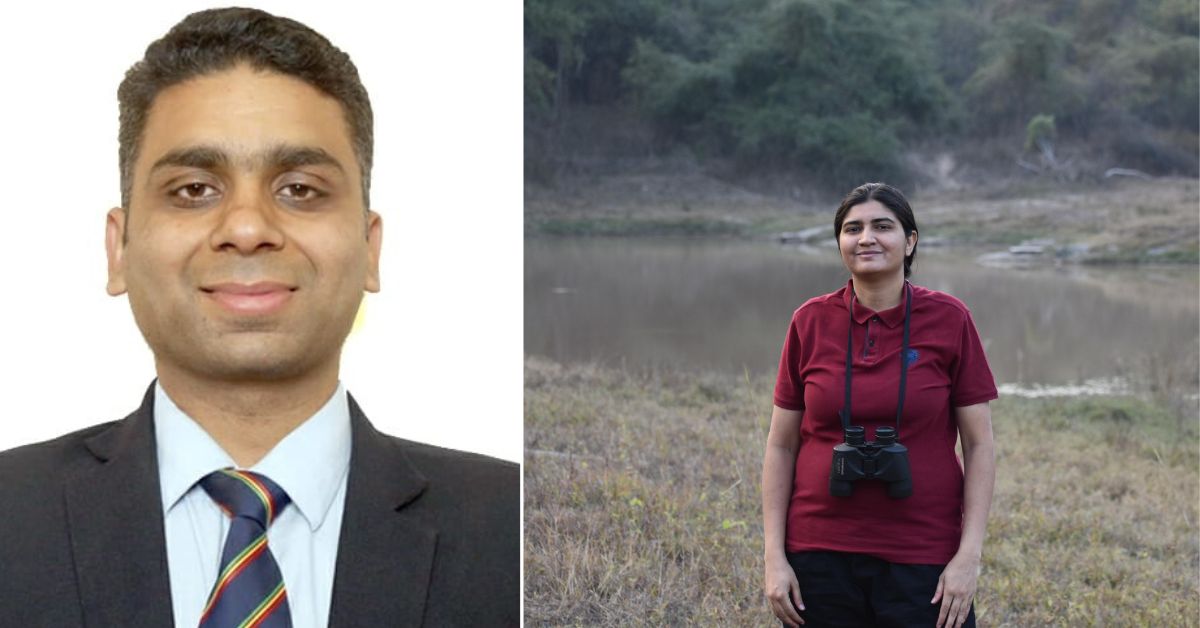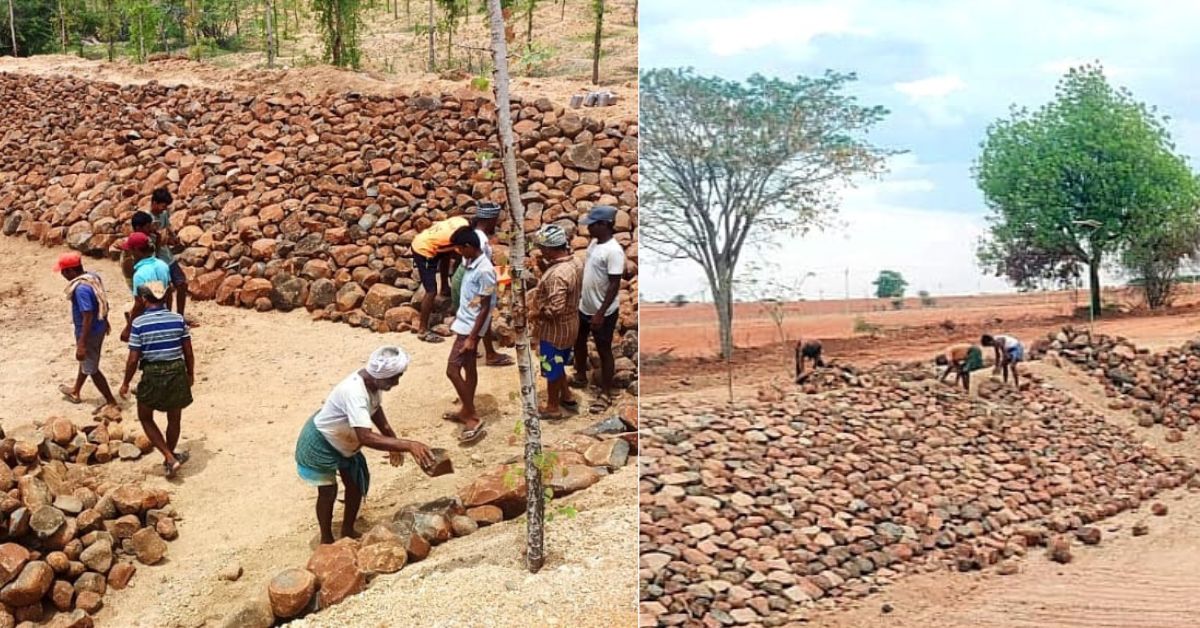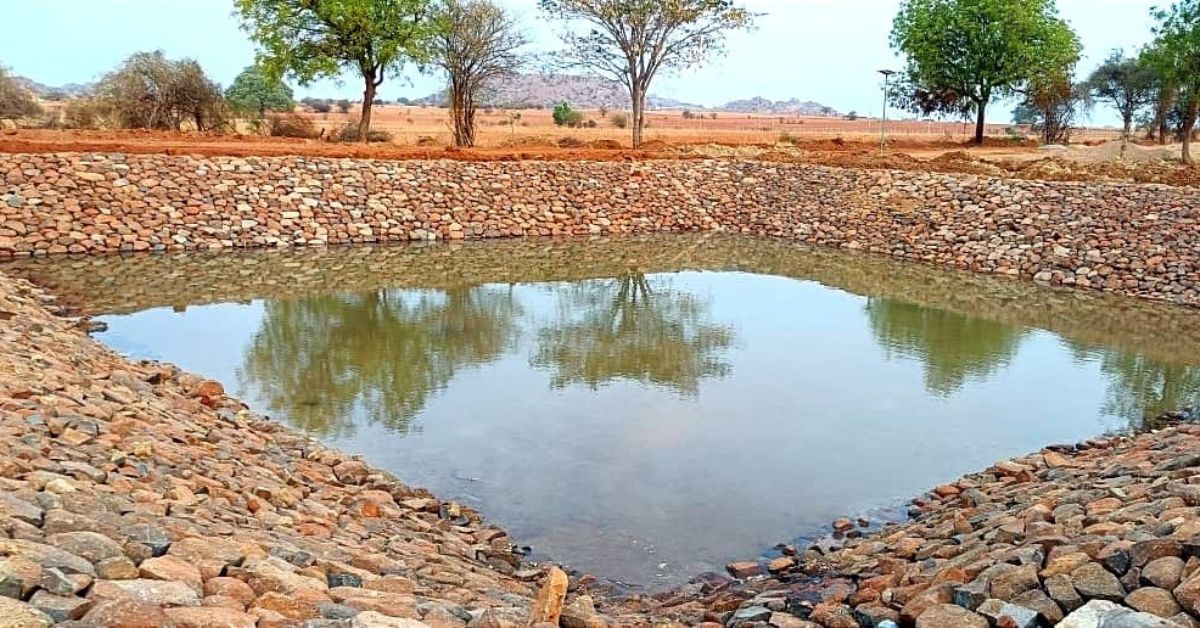This Couple & 400 Villagers Revived 11 Dead Water Bodies in Drought-Prone Anantapur
In remote corners of the Anantapur district of Andhra Pradesh, where dry earth and scarce water had long dictated the rhythm of life, a surprising scene began to unfold. Children swam and splashed joyfully in the newly revived ponds, and elders sat on the banks, marvelling at the shimmering water that was once a distant memory.
For years, villagers in Kalyandurgam and Rayadurgam hadn’t seen a single drop of water in areas that were once dumpsites. In March-April, 2024, they were transformed into natural oases. The reappearance of water bodies in both towns marked the start of a new chapter — one in which memories of drought began to fade, replaced by visions of prosperity.
 With the help of forest department and villagers, Vineet Kumar IFS and Rupak Yadav managed to revive water bodies in drought prone region.
With the help of forest department and villagers, Vineet Kumar IFS and Rupak Yadav managed to revive water bodies in drought prone region.
This moment was the result of an ambitious project launched by IFS officer Vineet Kumar, who, alongside wildlife conservationist and wife Rupak Yadav, spearheaded the ‘Ananta Niru Sanrakshanam’ project. The project aimed at reviving and creating water bodies as a lifeline for the community.
Navigating low rainfall, flash floods, and economic instability
“Known for its drought-prone conditions, the district’s annual rainfall hung precariously low at around 500 mm, just above the arid regions of Western Rajasthan. The district historically receives minimal rainfall due to its geographical position in the rain shadow region of the Western Ghats and its distance from the coast,” Vineet says.
“The erratic nature of rainfall, exacerbated by climate change, poses a significant challenge. Flash floods often occur within a couple of days, leaving the region dry for the remainder of the year. This led to economic instability, with many families forced to migrate in search of better opportunities,” he adds.
While civil society interventions had previously led to pipeline installations, slightly alleviating the drinking water crisis, the couple recognised that significant advancements could be made through the lens of water conservation.
Their overarching aim was to breathe life back into the community through innovative water conservation techniques and community engagement.
 Vineet and his team rejuvenated traditional water bodies, created new ones, and planted trees to protect these ecosystems.
Vineet and his team rejuvenated traditional water bodies, created new ones, and planted trees to protect these ecosystems.
Water bodies that were once dumpsites
Leveraging his role as a forest officer, Vineet saw potential in the large tracts of forested land under his management. During field visits, Vineet identified two critical areas: Kalyandurga and Rayadurgam.
Both locations, lacking in vegetation and plagued by poor soil conditions, presented opportunities for transformation. The lack of water conservation strategies and the misuse of forest lands for garbage dumping and antisocial activities underscored the need for immediate action.
Vineet and his team tackled issues such as siltation and waste dumping. They sought to rejuvenate traditional water bodies, create new ones, and plant trees that would sustain and protect these ecosystems.
How did they revive the waterbodies?
By constructing and reviving 11 water bodies, including ponds and old tanks – each capable of storing millions of litres of water, Vineet’s team sought to capture rainwater effectively.
 Vineet and Rupak roped in the Vadde community, local stone workers who played an essential role in water conservation efforts.
Vineet and Rupak roped in the Vadde community, local stone workers who played an essential role in water conservation efforts.
Other than clearing silted tanks, the efforts included utilising local stone materials to enhance water retention structures. They reinforced the embankments and bunds of local ponds, employing traditional techniques that required intensive labour from local stone workers.
Central to the project’s success was community engagement. Involving the local villagers proved pivotal. “We roped in the stone-working Vadde community, who were facing dwindling opportunities due to the rise of concrete construction,” he explains.
Rupak mentions that their goal was to build sustainable water structures while ensuring local community involvement. “This mission brought Vineet ji and me into collaboration with the Vadde community, local stone workers who played an essential role,” she adds.
“Beyond that, I actively participated in awareness and outreach activities, including creating online content to spread the conservation message. The initiative’s impact has extended well beyond mere water conservation — water is life. Reviving lost sources can restore ecosystems, support livelihoods, and secure our future,” she says while sharing her experience.
 The visual transformation, following the project’s implementation last year, was striking.
The visual transformation, following the project’s implementation last year, was striking.
When 400+ villagers came together
Rupak’s involvement also brought a crucial perspective to the project, emphasising the necessity of educating and involving the public. The combination of practical solutions with an educational component ensured the project’s sustainability and replicability.
Understanding that sustainable change required grassroots involvement, the couple engaged with local communities across several villages. Around 400 villagers participated in the project, actively contributing to the creation and maintenance of water bodies.
As these sites transformed, more than 7,000 native trees, such as neem and ficus, were planted around the water bodies, enhancing biodiversity and providing shade. The initiative nurtured a balanced ecosystem, which in turn supported the life that thrived nearby.
“The impact was immediate and visible. Where barren landscapes had been, blooming flora and thriving fauna now emerged. Birds returned, insects buzzed, and wildlife, such as the locally often-seen sloth bears, had a safer haven, avoiding conflict with human settlements,” shares the IFS officer.
“Farmers witnessed significant benefits as well. With improved groundwater recharge, local borewells began yielding more water, mitigating the impact of dry spells on agriculture. The project’s influence rippled into the economic sphere, stabilising livelihoods and providing job opportunities for the Vadde community,” he adds.
The project’s design emphasised low maintenance, ensuring its sustainability for years to come.
“A single borewell recharge system, crucial for maintaining groundwater levels, was implemented at a cost between Rs 30,000 and 50,000. Overall, the 11 reclaimed and newly created water bodies required an investment of Rs 10-15 lakh. This efficient allocation not only addressed immediate needs but also set a precedent for cost-effective environmental solutions applicable to similar regions,” shares Vineet.
 The initiative restored at least 11 water bodies.
The initiative restored at least 11 water bodies.
Celebrating new beginnings
As the first monsoon, following the project’s implementation, arrived last year, the visual transformation was striking. The project tapped into the cultural longing for water. Places once marred by seasons of neglect had become sites of congregation, learning, and joy.
The rejuvenation effort brought the town together. The once unused plots became community hubs, where children who had never known the joys of swimming found delight in the cool and refreshing pond water. For the elderly, it was a memory revived and a future rekindled with hope.
“The improved groundwater levels enabled the cultivation of crops with better yields, encouraging many to remain rather than migrate to distant cities. Farmers reported improved harvests, and the previously neglected Vadde community found renewed relevance and purpose,” says Vineet.
As Vineet transitioned to his next posting in Kadapa district, the legacy he left behind was the empowered community of Anantapur — one that now harboured a deeper understanding of water’s value and how to conserve it.
Edited by Vidya Gowri; All images courtesy Rupak Yadav
News